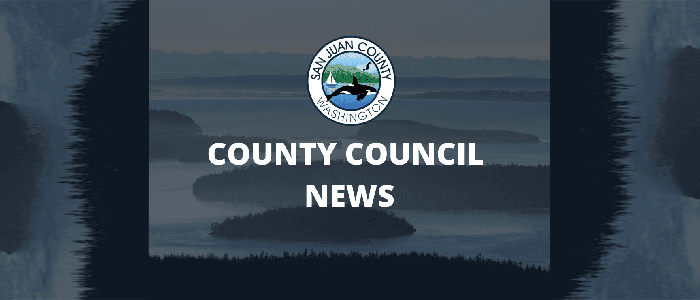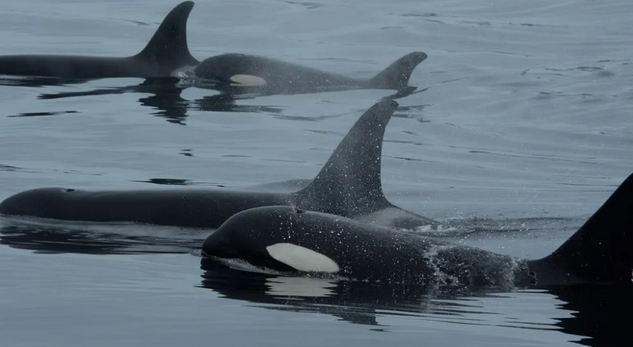It wasn’t that long ago
||| FROM CENTER FOR WHALE RESEARCH |||
In the early 1970s, more than 100 orcas were round-up and held captive in Penn Cove, Washington. Ten of these whales were sold to marine parks, the rest were set free. At least five whales died during this and two other capture operations.
On August 8, 1970, four-year-old female Southern Resident L pod orca, Tokitae (Sk’aliChelt-tenaut is her indigenous name), was torn from her mother and close-knit family and community and forced to live in a small aquarium tank. This and the other heartless captures—just to make a few bucks—marked the beginning of a new era for Pacific Northwest orcas: views of killer whales changed, live captures stopped, and Canada’s and the United States government and scientists began studying the now celebrated species of the Salish Sea.

A Salish Sea orca trapped in a net during the capture era. No doubt wondering: “What’s happening?” Photograph appears in KILLER WHALES Magnificent Creatures of the Salish Sea by Ken Balcomb and Rick Chandler.
While orcas (three regional ecotypes) have likely inhabited the Northeastern Pacific Ocean for thousands of years, it’s only been during the past fifty that humans have recognized the critical role these marine mammals play in a healthy ocean environment. A significant amount of what we’ve learned about these species has come from the science-changing research undertaken in the inland ocean of British Columbia and Washington State.
The First Peoples of the Salish Sea regarded the orca with great respect and a sage dose of fear. The essential bond between these peoples and orca has long been portrayed in their mythology and art.
“Many legends and beliefs grew up around the great sea mammals. If a whale was injured but not killed in the hunt, it would return at some other time and capsize the whaler’s canoe. A widespread belief held that a whale could capture a canoe and drag it and all those aboard down to the underwater Village of the Whales. Once there, the people would be transformed and themselves become whales. The Haida believed that whales appearing in front of a village were drowned persons returning to communicate with the people. Whales abound in the art of northwest coast peoples . . . The distinguishing features are clearly defined, and two or more are always present, no matter how minimal the portrayal. They are: a round snouted head with a large mouth and many teeth, a blow hole, a dorsal fin, a pectoral fin, and a tail with symmetrical flukes—although in profile the latter can appear asymmetrical.” From Looking at Indian Art of the Northwest Coast by Hilary Stewart.

First Peoples of the Salish Sea orca art. Photograph from KILLER WHALES Magnificent Creatures of the Salish Sea by Ken Balcomb and Rick Chandler.
In 1960, the Canadian Federal Fisheries Department hatched a plan to reduce the orca population by shooting the animals with machine guns. Before the cull started, the whales altered their feeding pattern. Did they know something was up? The land-based weapon was never used.

Attitudes toward orcas began to shift in 1961, with the first orca capture by Marineland of the Pacific in Newport Harbor, California. But just two days after being seized, the sick and disoriented female smashed head-on into the tank wall and died.
In 1964, the Vancouver Aquarium commissioned a sculptor to produce a life-sized replica of an orca for an aquarium addition. From the Strait of Georgia shoreline at East Point, Saturna Island, the artist harpooned a 15-foot long, 3-ton immature orca. The young Southern Resident J pod male* survived. Cruelly, the Aquarium director chose to keep it alive and transport it to Vancouver, against passionate objections by the local SPCA and others. Like a cow being led to slaughter, the juvenile whale was guided by harpoon line through the night, twenty miles across the Strait to Vancouver. Moby Doll remained captive for 87 days, becoming a worldwide celebrity (and a magnet for scientists).
Tragically, Moby Doll died in captivity. News of his passing circulated around the world. This global media interest was the first-ever positive press about killer whales. It was the start of a new appreciation for the species.
*Moby Doll’s identity as a member of J pod wasn’t determined until years after the fact, following an analysis of recorded vocalizations.
Tragically, Moby Doll died in captivity. News of his passing circulated around the world. This global media interest was the first-ever positive press about killer whales. It was the start of a new appreciation for the species.
THE LIVE CAPTURE YEARS
The second orca taken captive in the Pacific Northwest was a 24-foot long, 5-ton male. He had become entangled in a fishing net near Namu, British Columbia. The fisher offered their catch to the highest bidder. The owner of the Seattle Public Aquarium, Ted Griffin, grabbed the deal, buying Namu for eight thousand dollars—the replacement cost of the net.
Griffin constructed a floating pen so that his whale could be towed by tugboat the 450 miles to Seattle. During the journey, Namu repeatedly uttered loud, piercing cries. On day four, 30 to 40 orcas charged at the floating pen. As if trying to help Namu escape. Most of the pod left after a few hours; only a female and two calves stayed, traveling 150 miles alongside Namu. Were these his mother and siblings?
By 1965, Griffin had formed a partnership with Don Goldsberry to capture orcas in Washington State waters for aquarium exhibitions. Two killer whale trapping enterprises were also functioning along Canada’s west coast.
The capture methods employed were:
-
Surprise attack a pod of orcas entering a narrow, shallow inlet; if they were reluctant, seal bombs—explosive devices—were used to direct them into the bay. A net was raised behind them, so the pod was boxed in. Individual orcas were chosen from the families and forced into smaller pens.
-
Circle the animals with a purse seine—a towering wall of netting deployed around a specific ocean area (usually containing a school of fish). Once the pod of orcas was located, the boat encircled them with the net, pulled in the lead line, “pursing” the net closed and stopping the whales from escaping downward or sideways.
One of Ted Griffin’s goals was to quell the idea that orcas were vicious predators. During Namu’s first day performing in the Seattle Public Aquarium in the summer of 1965, Griffin entered the water with Namu and rode on his back. The orca was an instant star. The two performed as a team for eleven months. Then Namu developed a bacterial infection. The virus damaged his central nervous system. In June 1966, he smashed head-on into his wire-mesh pen, thrashed frenziedly for several minutes, and died.
PENN COVE CAPTURES
Captures along Whidbey Island, Washington, in the late 1960s and early 70s were watershed moments in popular opinion toward orcas. Public outcry peaked in 1970 when more than 100 orcas were corralled in Penn Cove on three separate occasions. Ten animals were sold to marine parks, the rest were set free. No less than five orcas died during the capture operations; three were discovered sliced open and weighted down with rocks and anchors.
Tokitae/Sk’aliChelt-tenaut was one of the Penn Cove captures. Next, she was moved to her new home in the Miami Seaquarium in Florida (staff there renamed her Lolita). Tokitae has been jailed in a puny aquarium tank several times her body length for half a century. It’s a far cry from the vastness of her home in the wild where, if unshackled, she’d be swimming as far as a hundred miles a day with her mother, siblings, and cousins. Instead, she’s performed monotonous, unnatural activities for cheering humans: day after day, year after year.
Tokitae has been jailed in a puny aquarium tank several times her body length for half a century.

Watch the YouTube video Draw My Life: Listen to Lolita, the Orca, Tell Her Story, a narrated story about Tokitae/Sk’aliChelt-tenaut’s capture and life in Miami Seaquarium.
Other orcas died during the booming business of apprehending whales for eventual captive entertainment. In August 1970, a young female stranded in Port Madison, Bainbridge Island, was moved to West Germany. She died of unknown causes a year later. A female captured at Ocean City in 1973 lived four and a half years in Sea World aquariums before dying of a cerebral hemorrhage.
THE INFAMOUS BUDD INLET CONFLICT
Early in 1976, SeaWorld’s Don Goldsberry shepherded six orcas into Puget Sound. By chance, Washington State Governor’s assistant—and future WA Secretary of State—Ralph Munro and his wife, Karen, were sailing in the area. The Munro’s witnessed Goldsberry’s use of planes, power boats, and seal bombs to direct the whales, eventually using nets to hold them in Budd Inlet.
In the Introduction to KILLER WHALES Magnificent Creatures of the Salish Sea by Ken Balcomb and Rick Chandler, Ralph Munro reflects on the impact that orcas and caring whale people have had on his life and why everyone should hear their stories.
“Having my dad wake me as a little boy to listen to the whales breathing as they rested in the cove where we lived, watching these majestic creatures chasing salmon down Port Orchard Channel near our Bainbridge Island cottage in the 1950s, hearing the gunshots as fishermen shot at the whales near their nets, watching Ted Griffin drag captured Namu’s net pen under the Deception Pass Bridge in the 1960s, letters from my dad that Griffin was swimming with Namu at the winter cove location near Rich Passage, the trauma of sailing into the middle of a Sea World capture operation in Budd Inlet in 1976, days and nights in the courtrooms defending these magnificent creatures against capturing aquariums and our own government, having J6 named after me, seeing the pods protected at last from capture and harassment . . . the list goes on and on.
From the beginning, there have been superstars: Michael Bigg, Paul Spong, Ken Balcomb, Rick Chandler, Graeme Ellis, John Ford, and many others . . . people who were willing to dedicate their entire lives to the protection of our killer whales.”
Ironically, just a few miles from Budd Inlet, a three-day killer whale conference was underway at Evergreen State College. One of the conference’s central topics was putting an end to Washington State orca captures. It didn’t take long for conference attendees—U.S. and Canadian cetacean researchers, wildlife advocates, marine biology students, and others—to become spectators of the Budd Inlet proceedings. Ken Balcomb and his just-established ORCA SURVEY team were among those present.
The orca hostage-taking infuriated observers, as well as state public officials. Washington State Governor Dan Evans, and Attorney General Slade Gorton, quickly filed a lawsuit in Seattle district court, charging inhumane practices against SeaWorld. The judge ordered the marine-mammal park operator to release the whales and to relinquish its permit to collect orcas in the state waters. Media of every description devoured the storyline, making it headline news around the world.
The district court judge’s added demand was that custody of two of the Budd Islet captures be given to the University of Washington for a research project. At first, the orcas were known as O5 and O4 but were redesignated: T13 and T14 (likely Bigg’s Transients mother and son).
The two indentations on T14 dorsal fin’s leading edge in 2009 are scars from the radio tags mounted there when captured in 1976. Photograph from KILLER WHALES Magnificent Creatures of the Salish Sea by Ken Balcomb and Rick Chandler.
On April 26, 1976, seven weeks after their capture, T13 and T14 were moved to Kanaka Bay on San Juan Island and released into the wild. The whales were followed by boat for the first ten days, then the radio signals were lost. The signal occasionally materialized during the next five months before vanishing entirely. The subsequent physical encounter with T13 and T14 in 1979 revealed that they’d lost their tag packs but that the anchoring screws survived.
Read CWR’s Ken Balcomb’s handwritten logbook entry from the day radio-tagged T13 and T14 were released from Kanaka Bay, San Juan Island.
ORCA SURVEY begins
Captors of orcas assumed that there were hundreds or thousands of killer whales in Pacific Northwest waters. Pressured by public concern for the well-being of the animals—who’d proven to be docile, intelligent, and capable of learning—Canada’s Department of Fisheries and Oceans decided to try and solve the population puzzle. It hired marine biologist, Dr. Michael Bigg, to undertake a census of orcas around British Columbia.
Dr. Bigg was asked to answer:
- What is the total number of killer whales inhabiting these waters?
- Are these whales a discrete local population, or are they just a few of the thousands of killer whales inhabiting the Pacific Ocean that wander into these waters?
- Are the killer whales taken in Washington State waters from the same stock as British Columbia?
After an extensive public sighting program, including distributing questionnaires to fishermen, lighthouse keepers, and others living and working along the west coast, Dr. Bigg’s initial results estimated the British Columbia orca population at 200-250—drastically fewer than whale “collectors” thought.
Not long after the Canadian’s completed their study, the United States government decided to follow suit, and, in 1976, ORCA SURVEY was launched in Washington State to determine the status of the newly defined population of Southern Resident killer whales (SRKW).
Read about the Center for Whale Research and ORCA SURVEY’s history, including a 13-minute video of Encounter #1 (April 8, 1976), narrated by CWR’s founder and senior scientist, Ken Balcomb, reading his handwritten logbook entry.
Forty-Five Years of Research
For five decades, the Center for Whale Research (CWR) has conducted an annual photo-identification study—ORCA SURVEY—of the Southern Resident orca population that frequents the inland waters of Washington State and lower British Columbia. These studies have provided unprecedented baseline information about population dynamics and demography, health, social structure, and individual life histories of these whales. More is known about these orcas than about any other group of marine mammals in the world.
No orcas have been captured in United States waters since 1976.
**If you are reading theOrcasonian for free, thank your fellow islanders. If you would like to support theOrcasonian CLICK HERE to set your modestly-priced, voluntary subscription. Otherwise, no worries; we’re happy to share with you.**










